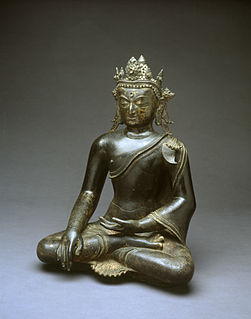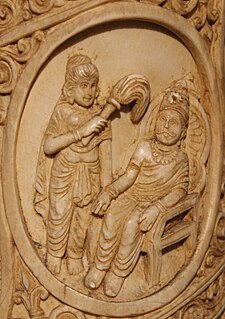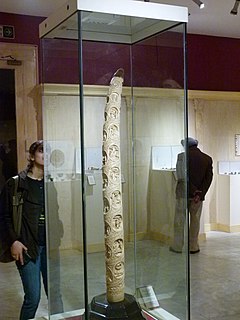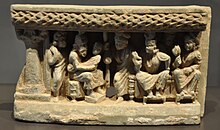
The Buddha was a philosopher, mendicant, meditator, spiritual teacher, and religious leader who lived in Ancient India. He is revered as the founder of the world religion of Buddhism, and worshipped by most Buddhist schools as the Enlightened One who has transcended Karma and escaped the cycle of birth and rebirth. He taught for around 45 years and built a large following, both monastic and lay. His teaching is based on his insight into duḥkha and the end of dukkha – the state called Nibbāna or Nirvana.

The Shakya were a clan of Iron age India, inhabiting an area in Greater Magadha, situated at present-day southern Nepal and northern India, near the Himalaya. The Shakyas formed an independent oligarchic republican state known as Śākya Gaṇarājya. Its capital was Kapilavastu, which may have been located either in present-day Tilaurakot, Nepal or present-day Piprahwa, India.
The four sights are four events described in the legendary account of Gautama Buddha's life which led to his realization of the impermanence and the ultimate dissatisfaction of conditioned existence. According to this legend, before these encounters Gautama Siddhartha had been confined to his palace by his father, who feared that he would become an ascetic if he came into contact with sufferings of life according to a prediction. However, his first venture out of the palace affected him deeply and made him realize the sufferings of all humans, and compelled him to begin his spiritual journey as a wandering ascetic, which eventually led to his enlightenment. The spiritual feeling of urgency experienced by Siddhārtha Gautama is referred to as saṃvega.

Rāhula was the only son of Siddhārtha Gautama, and his wife and princess Yaśodharā. He is mentioned in numerous Buddhist texts, from the early period onward. Accounts about Rāhula indicate a mutual impact between Prince Siddhārtha's life and the lives of his family members. According to the Pāli tradition, Rāhula was born on the day of Prince Siddhārta's renunciation, and was therefore named Rāhula, meaning a fetter on the path to enlightenment. According to the Mūlasarvāstivāda tradition, and numerous other later sources, however, Rāhula was only conceived on the day of Prince Siddhartha's renunciation, and was born six years later, when Prince Siddhārtha became enlightened as the Buddha. This long gestation period was explained by bad karma from previous lives of both Yaśodharā and of Rāhula himself, although more naturalistic reasons are also given. As a result of the late birth, Yaśodharā needed to prove that Rāhula was really Prince Siddhārtha's son, which she eventually did successfully by an act of truth. Historian H.W. Schumann has argued that Prince Siddhārtha conceived Rāhula and waited for his birth, to be able to leave the palace with the king and queen's permission, but Orientalist Noël Péri considered it more likely that Rāhula was born after Prince Siddhārtha left his palace.

Śuddhodana, meaning "he who grows pure rice," was a leader of the Shakya, who lived in an oligarchic republic on the Indian subcontinent, with their capital at Kapilavastu. He was also the father of Siddhartha Gautama, who later became The Buddha.

Queen Māyā of Sakya was the birth mother of Gautama Buddha, the sage on whose teachings Buddhism was founded. She was sister of Mahāpajāpatī Gotamī, the first Buddhist nun ordained by the Buddha.

Kātyāyana or Mahākātyāyana was a disciple of Gautama Buddha. He is listed among one of the ten principal disciples and was foremost in expanding on and explaining brief statements of the Buddha.
The Lalitavistara Sūtra is a Sanskrit Mahayana Buddhist sutra that tells the story of Gautama Buddha from the time of his descent from Tushita until his first sermon in the Deer Park near Varanasi. The term Lalitavistara has been translated "The Play in Full" or "Extensive Play," referring to the Mahayana view that the Buddha’s last incarnation was a "display" or "performance" given for the benefit of the beings in this world.
Channa - The Divine Charioteer was a royal servant and head charioteer of Prince Siddhartha, who was to become the Buddha. Channa later became a disciple of the Buddha and achieved arahantship, as is described in the 78th verse of the Dhammapada.

Kaundinya, Kauṇḍinya, or Koṇḍañña (Pali), also known as Ājñātakauṇḍinya, Pali: Añña Koṇḍañña, was a Buddhist monk follower of Gautama Buddha and the first to become an arhat. He lived during the 6th century BCE in what are now Uttar Pradesh and Bihar, India. According to traditional accounts, at the time of Gautama Buddha's birth, he predicted his future destination as an enlightened teacher.

Kanthaka was a favourite white horse of length eighteen cubits that was a royal servant of Prince Siddhartha, who later became Gautama Buddha. Siddhartha used Kanthaka in all major events described in Buddhist texts prior to his renunciation of the world. Following the departure of Siddhartha, Kanthaka died of a broken heart.

Assaji was one of the first five arahants of Gautama Buddha. He is known for his conversion of Sariputta and Mahamoggallana, the Buddha's two chief male disciples, counterparts to the nuns Khema and Uppalavanna, the chief female disciples. He lived in what is now Uttar Pradesh and Bihar in northern India, during the 6th century BCE.
Anuruddha was one of the ten principal disciples and a cousin of Gautama Buddha.
The Buddha was born into a noble family of the kshatriyas in Lumbini in 563 BCE as per historical events and 624 BCE according to Buddhist tradition. He was called Siddhartha Gautama in his childhood. His father was king Śuddhodana, leader of the Shakya clan in what was the growing state of Kosala, and his mother was queen Maya Devi. According to Buddhist legend, the baby exhibited the marks of a great man. A prophecy indicated that, if the child stayed at home, he was destined to become a world ruler. If the child left home, however, he would become a universal spiritual leader. To make sure the boy would be a great king and world ruler, his father isolated him in his palace and he was raised by his mother's younger sister, Mahapajapati Gotami, after his mother died just seven days after childbirth.
Ten Bodhisattas refer to ten future Buddhas during their lives as bodhisattvas. They have also been referred to as successors of Gautama Buddha.
Buddha - Rajaon Ka Raja is a historical drama on Zee TV and Doordarshan, produced by Bhupendra Kumar Modi, under the banner Spice Global. The creative producer of the show is Shetall Siingh. The show first aired on Sunday, 8 September 2013 at 11:00 am on Zee TV and Doordarshan. The programme stars Kabir Bedi in a cameo role as Asita Muni, the sage who announces the coming of Gautama Buddha. The story of the serial is based on the life of Buddha that shows how a prince, Siddhartha, became a Buddha. The role of Mayadevi - scheduled to be played by Sameksha Singh - was replaced with Deepika Upadhyay. Himanshu Soni is playing the lead role of Buddha, while 2010 Miss India top ten finalist, Kajal Jain is playing role of Siddhartha Gautama's wife Yaśodharā. Earlier, Ashutosh Gowariker wanted to collaborate with Shekhar Kapur for a television series on Buddha.

In Buddhist texts, Sumedha is a previous life of Gotama Buddha in which he declares his intention to become a Buddha. Buddhist texts describe that this takes place when Gotama Buddha is still a Buddha-to-be. Traditions regard Sumedha's life as the beginning of the spiritual journey leading up to the attainment of Buddhahood by Gotama in his last life, a journey which takes place through many lifetimes. Born in a brahmin family, Sumedha begins to live as an ascetic in the mountains. One day he meets Dīpankara Buddha and offers his own body for him to walk over. During this sacrifice, he makes a vow that he also will be a Buddha in a future lifetime, which is confirmed by Dīpankara through a prophecy.
According to Theravada Buddhism's Pali canon's Buddhavamsa and its commentary, Sumedha Buddha is the fourteenth of twenty-seven Buddhas who preceded the historical Gotama Buddha. Sumedha Buddha was born in Sudassana. According to the canon at the age of 9,000 years old he became an ascetic, practiced austerities for fifteen days, and attained Enlightenment. He lived 90,000 years, and died in Medhārāma.

Carved elephant tusk depicting Buddha life stories is an intricately carved complete single tusk now exhibited at the Decorative Arts gallery, National Museum, New Delhi, India. This tusk was donated to the Museum. This tusk, which is nearly five foot long, illustrates forty three events in the life of the Buddha and is thought to have been made by early 20th century craftsmen from the Delhi region.

The Great Renunciation or Great Departure is the traditional term for the departure of Gautama Buddha from his palace at Kapilavastu to live a life as an ascetic. It is called the Great Renunciation because it is regarded as a great sacrifice. Most accounts of this event can be found in post-canonical Buddhist texts from several Buddhist traditions, which are the most complete. These are, however, of a more mythological nature than the early texts. They exist in Pāli, Sanskrit and Chinese language.











